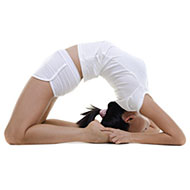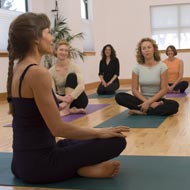How To Do Kapotasana & What Are The Therapeutic Applications?
A complete backbend, the kapotasana or the King Pigeon pose is one which is slightly difficult to master.
Though it appears to be easier than some of the other advanced poses, inversions, and backbends, the king pigeon pose requires a lot of practice before you can perfect it and perform it with ease.
Steps :
- Keep yourself upright and kneel keeping your legs slightly apart. Keep your shoulders and head bent backwards.
- Bring your hands behind you and press at the back of your pelvis with a slight force.
- Inhale deeply and bow your head, tucking your chin into your sternum. Lean your shoulders back. While doing this, try and keep your hips in place.
- Keep your shoulder blades firm and lift your chest as high as you can. Now gradually release your head and let it tilt back.
- Bring both your hands in front of you in the Anjali mudra.
- Now slowly place your hands on the floor and bring your forehead to the floor as well.
- Take a deep breath and raise your hands, arching them backwards. Move your hips forward so that you can counterbalance this move.
- Allow your upper thighs to be perpendicular to the floor and drop back. Touch your ankles with your hands and if you can, grab your heels.
- Rest the back of your head on the soles of your feet.
- Open the front of your groin as much as possible and lift your pelvis. Now lengthen your upper spine and lower your forearms. Draw in your elbows towards each other.
- Extend your neck and place your forehead on the floor.
- Inhale deeply.
Now softly exhale and press both your forearms and your shin to the floor. Hold the pose for about 30 seconds and keep breathing normally. - Exhale and expand your chest. Now release your grip on your heels and slowly come back to the kneeling position.
Precautions :
- The exercise is not recommended for those suffering from insomnia, frequent migraines, and hypertension.
- If you have had a serious injury to your back or your neck, avoid performing any back bend.
Beginner’s Tip:
If you are not able to perform this pose naturally, kneel with your back to a wall and press the soles of your feet to it. Now bend backwards and rest the crown of your head against the wall. You may also place your hands against the wall. You can perform this pose as a half backbend instead of the full one.
Benefit To Body Part :
- Flexes the hips and the groin
- The muscles in the chest, neck and shoulders are stretched which helps in better body posture.
- Flexes the thigh muscles and helps relieve back pain.
Therapeutic Application :
- The King Pigeon pose is considered ideal for women trying to conceive.
- The pose stretches your torso and strengthens the core.
- It works the deep hip flexors.
- It strengthens the lower back muscles.
- It realigns the spine and improves posture.
- It realigns the uterus and stimulates all the organs in the abdominal region as well as in the neck.
Variations:
- One-Legged King Pigeon Pose (Eka Pada Rajakapotasana)
This is also considered a preparatory pose to the Kapotasana.
Preparatory Poses :
- Bow Pose (Dhanurasana)
- Cobra Pose (Bhujangasana)
- One Legged King Pigeon Pose (Eka Pada Rajakapotasana)
- Bridge Pose (Setu Bandha)
- Hero Pose (Virasana)
- Upward Bow (Urdhva Dhanurasana)
- Reclining Hero Pose (Supta Virasana)
Follow Up Poses:
- Noose Pose (Pasasana)
- Child's Pose (Balasana)
- Downward-Facing Dog (Adho Mukha Svanasana)
- Bharadvaja's Twist (Bharadvajasana I)



